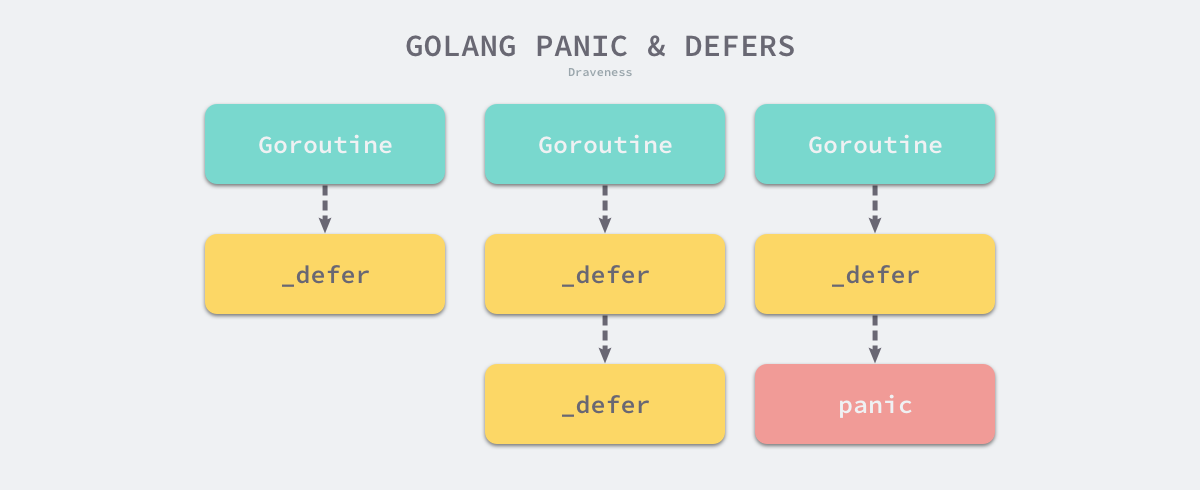Golang panic&recover 详解
Golang panic&recover 详解
前言
近期在编写并发 goroutine 以及超时控制时,出现了意料之外的没有 handle 住的 panic ,导致程序直接退出
具体场景大致如下:
func main() {
defer myRecover()
ctx, canceller := context.WithTimeout(context.Background(), 1*time.Minute)
defer canceller()
startTime := time.Now()
done := make(chan struct{}, 1)
// do task
go func() {
defer close(done)
panic("some panic")
done <- struct{}{}
}()
select {
case <-ctx.Done():
if ctx.Err() != nil {
zaplog.Logger.Error("ctx.Done closed", zaplog.Error(ctx.Err()), zaplog.Any("timeCost", time.Since(startTime)))
} else {
zaplog.Logger.Error("ctx.Done closed, no error, get sys message to quit")
}
return
case msg, ok := <-done:
if !ok {
panic(fmt.Sprintf("done closed without sending any message"))
}
zaplog.Logger.Info("done closed, get message", zaplog.Any("msg", msg), zaplog.Any("timeCost", time.Since(startTime)))
return
}
ticker := time.NewTicker(1 * time.Second)
count := 0
for range ticker.C {
count++
zaplog.Logger.Info("main loop...", zaplog.Int("count", count))
}
}
func myRecover() {
if err := recover(); err != nil {
errMsg := fmt.Sprintf("======== Panic ========\nPanic: %v\nTraceBack:\n%s\n======== Panic ========", err, string(debug.Stack()))
zaplog.Logger.DPanic(errMsg)
}
}实际运行情况是 main 中没有打印出done closed, get message的日志,直接退出了程序

值得注意的是,我们在 main 中是有进行 panic 的统一异常处理的,但是很明显的是 Goroutine 的外层的 defer 并没有 cover 住这个异常
需要了解的词
- Goroutine Goroutine 是Go语言中并发的执行单位,可以认为 Go 协程是轻量级的线程,由 Go 运行时来管理
- panic
能够改变程序的控制流,调用
panic后会立刻停止执行当前函数的剩余代码,并在当前 Goroutine 中递归执行调用方的defer

- recover
可以中止
panic造成的程序崩溃。它是一个只能在defer中发挥作用的函数,在其他作用域中调用不会发挥作用
原因分析
首先我们要知道panic和recover的特性:
panic只会触发当前 Goroutine 的deferrecover只有在defer中调用才会生效panic允许在defer中嵌套多次调用

多个 Goroutine 之间没有太多的关联,自然一个 Goroutine 在 panic 时也不应该执行其他 Goroutine 的延迟函数;具体到实现来说,之所以 panic 只会对当前 Goroutine 的 defer 有效是因为在 newdefer 分配 _defer 结构体对象的时,会把分配到的对象链入当前 Goroutine 的 _defer 链表的表头中(如下图所示)

实际上 panic的数据结构为:
type _panic struct {
argp unsafe.Pointer // pointer to arguments of deferred call run during panic; cannot move - known to liblink
arg interface{} // argument to panic
link *_panic // link to earlier panic
pc uintptr // where to return to in runtime if this panic is bypassed
sp unsafe.Pointer // where to return to in runtime if this panic is bypassed
recovered bool // whether this panic is over
aborted bool // the panic was aborted
goexit bool
}- argp 是指向 defer 调用时参数的指针
- arg 是我们调用 panic 时传入的参数
- link 指向的是更早调用
runtime._panic结构,也就是说 painc 可以被连续调用,他们之间形成链表 - recovered 表示当前
runtime._panic是否被 recover 恢复 - aborted 表示当前的 panic 是否被强行终止
从数据结构中的 link 字段我们就可以推测出以下的结论:panic 函数可以被连续多次调用,它们之间通过 link 可以组成链表
结构体中的 pc、sp 和 goexit 三个字段都是为了修复 runtime.Goexit 带来的问题引入的1。runtime.Goexit 能够只结束调用该函数的 Goroutine 而不影响其他的 Goroutine,但是该函数会被 defer 中的 panic 和 recover 取消2,引入这三个字段就是为了保证该函数的一定会生效
所以实际的 panic 流程是这样的:

实际修复与测试
再看回我们的实际场景
外层的 select 会阻塞住主进程,panic 是在内层的 goroutine 中触发的,所以会先执行 goroutine 中的 defer,即:
func() { done <- struct{}{} }()close(done)
当 close(done)后,正常情况下外层 select case 中的 case msg, ok := <-done:解除阻塞,但这时内层 goroutine 的 defer 已经执行完了,没有被 recover ,直接导致程序退出,外层的 recover 并不能保证程序的继续运行
在内层 goroutine task 中加入 defer myRecover()后,外层仍可正常运行main loop
func main() {
defer myRecover()
ctx, canceller := context.WithTimeout(context.Background(), 1*time.Minute)
defer canceller()
startTime := time.Now()
done := make(chan struct{}, 1)
// do task
go func() {
defer myRecover()
defer func() {
ticker := time.NewTicker(time.Second)
defer ticker.Stop()
count := 0
for range ticker.C {
count++
zaplog.Logger.Info("waiting for recover...", zaplog.Int("count", count))
if count >= 5 {
zaplog.Logger.Info("no recover, panic...")
return
}
}
}()
defer close(done)
defer func() { done <- struct{}{} }()
panic("some panic")
}()
select {
case <-ctx.Done():
if ctx.Err() != nil {
zaplog.Logger.Error("ctx.Done closed", zaplog.Error(ctx.Err()), zaplog.Any("timeCost", time.Since(startTime)))
} else {
zaplog.Logger.Error("ctx.Done closed, no error, get sys message to quit")
}
return
case msg, ok := <-done:
if !ok {
panic(fmt.Sprintf("done closed without sending any message"))
}
zaplog.Logger.Info("done closed, get message", zaplog.Any("msg", msg), zaplog.Any("timeCost", time.Since(startTime)))
}
ticker := time.NewTicker(1 * time.Second)
count := 0
for range ticker.C {
count++
zaplog.Logger.Info("main loop...", zaplog.Int("count", count))
}
}
func myRecover() {
if err := recover(); err != nil {
errMsg := fmt.Sprintf("======== Panic ========\nPanic: %v\nTraceBack:\n%s\n======== Panic ========", err, string(debug.Stack()))
zaplog.Logger.DPanic(errMsg)
}
}总结
关键点就在于panic和recover的特性——recover 只有在 defer 中调用才会生效
